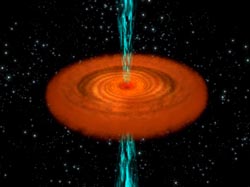
(Image Credit: ESA/Christopher Carreau)
While observing a sample of quasars with broad absorption line (BAL) in their spectra, Prof. WANG Junxian together with his colleagues Prof. WANG Tinggui and Dr. ZHOU Hongyan with the Center for Astrophysics at the University of Science and Technology of China (USTC) recently discovered that unlike most of BAL quasars, two of the observed do not show intrinsic X-ray absorption, indicating a different composition of matter in their outflows. This might help us better understand how black holes devour and project gases, according to the astronomers.
The sampled quasars keep throwing gases into the space along their polar axes, instead of equatorial direction as most of their counterparts do, as revealed by previous observations conducted by the same group of astronomers. Once again the new data obtained from the same objects surprised the astronomers, because strong X-ray absorption is widely believed to be among the most prominent characteristics of most BAL quasars.
Quasars have been intriguing objects of research for astronomers since the late 1950s, when the first of them were detected with radio telescopes. Short for "QUASi-stellAR radio source," a quasar gives strong emissions of electromagnetic energy, including radio waves and visible light. Judged from the high redshift in their spectra, this kind of celestial bodies is estimated to be extremely far away from the Earth. Most quasars are farther than three billion light-years, and the farthest known to date is around 28 trillion light-years away. This unimaginable distance means that they could work as emissaries from the early evolution of our cosmos, bringing us precious clues about the aftermath of the Big Bang, which is hypothesized as the origin of our universe.
A fascinating property of quasars is the enormous amount of matter they draw from and throw back into the universe, which gives them the nickname of "cosmic engines." Scientists have come to a consensus that quasars are active galaxies, or young galaxies still in their formative era, each with a supermassive black hole at the center. The central black hole feeds on a large amount of dust and stars, which release enormous gravitational energy in the form of strong electromagnetic radiation when collapsing into the bottomless black hole.
Interestingly, while voraciously devouring matter, some quasars also discharge gases into the space at certain directions. The wide absorption lines appearing in their spectra are actually the imprints of these gases, which absorb some light of certain wavelengths and hence leaving shadows on the otherwise continuous spectra. It was previously believed that BAL quasars eject the gases along the equatorial direction, parallel to their accretion discs, which are formed by the matter continuously dropping into the nucleus of the growing galaxy, the supermassive black hole. The USTC group, however, identified a special kind of quasars two years ago, which propel gases along their polar axes, a direction perpendicular to their accretion disk. Using XMM-Newton, a satellite administered by the European Space Agency, this group made further observations on these quasars during 2006 and 2007, trying to make clear whether these eccentric celestial bodies absorb X-rays, as most BAL quasars do.
To their surprise, the latest data suggest that these polar BAL quasars are almost "transparent" to X-rays, as they do not appear strong absorption of X-rays. This implies that these polar BAL quasars might eject gases in a way more complicated than expected, as reported by the astronomers in their paper published in the April issue of The Astrophysical Journal Letters of USA.
When analyzing the snapshot observations of four polar BAL quasars, the group found that two of the radiation sources could be detected in X-ray. The spectral model fittings indicated that these objects were X-ray normal, suggesting that X-ray shielding gas, like neutral gases, might be absent in their outflows. According to the authors, this could also imply that the nature of polar outflows is possibly different from that of equatorial outflows, and polar BAL quasars might occur at larger distances than their equatorial peers. The data obtained so far, however, are not sufficient to rule out alternative reasons, including an absorption mode more complex than conceived, for example a partial covering of X-ray absorbing gases, and an extra contribution of X-ray to the spectra due to possible emission of this kind of radiation.
The outflows from the black hole interest astrophysicists because they might create disturbance in the host galaxy, and moreover, might prevent new stars from forming. This new discovery could help researchers improve their computer simulation of the dynamic activity of quasars, hence better understanding how these mysterious celestial bodies devour and eject gases, and through which influence the evolution of the host galaxies.





